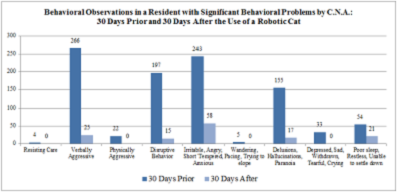| Robocats/Robopups: Awakening the Isolated with Robotic Animals |
Participant's Choice Award: 2017 Poster Sessionby Veronica McBride, MSW; Andrea Adorno, TRS; Anne Monaco, TRS; Rebecca Ferrini, MD, MPH, CMDEdgemoor DPSNF, County of San Diego
Background/ObjectiveFor many residents with severe impairments, it is difficult to find recreation activities that they can engage in, particularly between scheduled activities. Many have minimal response to the environment, short attention spans, and a lack of connections with others. Reviews of nonpharmacological treatments for dementia find little research supporting robotic pet therapy (O’Neil et al 2011), but anecdotal evidence (Herzog 2016, Hunter 2017) show that animal therapy can improve quality of life, interaction and engagement. We identified a low cost interactive robotic pet made by Hasbro called “Joy for all Companion Pets” available in 2016. Robotic pets come in three cat model (0range tabby, white and silver—all $99) and one dog variety (Golden pup $119). These robotics are far cheaper than Paro which costs thousands of dollars. The animals respond to petting and hugging with motion sensors responding to motion and touch. Fur and weight feel like a real cat (even a small amount of shedding). Movements and sounds the robot makes simulate a real animal, especially purring, meows, barks and head turning. Each robotic pet takes 4 C batteries. Excerpt from cat care guide. Images on file
Methods/Study DesignWe identified residents who might benefit and had unspent funds in their account. We obtained permission to assist in purchase and were able to get bulk discounts (25%). We purchased, tested and distributed 33 robotic pets. We purchased two for the facility to trial on residents prior to purchasing. Each animal was given to the resident by the social worker, then worked with therapeutic recreation staff to incorporate the robotic animal therapy into their visits (2-3 times a week). The therapist would place the animal in the arms of the resident, talk about it, then leave the resident alone with the animal. If a resident requested the animal, or a nurse was motivated, the animal was offered at others times as well. ResultsWe were surprised to discover heart-rending stories of nonverbal individuals speaking to name a pet; those who had been vegetative who now reached for, smiled and interacted with a robotic animal. Even staff who were not animal lovers were engaged by the responsive motions. No resident, even those with aggression or history of throwing items, threw or harmed their robotic animal. One resident exhibited noticeable changes in behavioral monitoring in the weeks after the new cat arrived.
Another patient exhibited a wide variety of emotions; smiling, twitching his eyes, moving his upper torso, and trying to reach out for the robotic cat. He demonstrated positive affect when he was presented with his robotic cat. It is now sitting on top of his closet facing him and meowing periodically, and turning over. The patient has a clear view of his robotic cat. She became very alert and focused. Her hand tried to touch it but she was unable to grab it due to hand contracture. She smiled so much; eyes wide. Then later was overwhelmed with emotions and cried like a baby. She later calmed down and was relaxed looking at her robotic cat from the top of her closet facing straight at her.
Even staff enjoyed holding and petting the mechanical animal—calming!
AnalysisNegative outcomes:2/33 residents did not like it, one resident stated “it is for kids” and a patient with active psychosis was disturbed by the meowing and gave it away. One resident grabbed a peer’s cat. Challenges:
Benefits:
Conclusions/InterpretationsThese inexpensive robotic animals engaged a population of residents who are not easily reached by other methods, clearly enhancing quality of life. These animals may be especially helpful for those who are animal lovers and long for their childhood pet and also show some preliminary benefits in adverse behavioral reductions. References
|







 One man was coming out of his shower and heard the cat meow. He said, “What is that?” I said to him that his cat is here now. He smiled, saying, “Oh!” I put the cat on his lap; wrapped his arm around it. It meowed again and he called her Jaime. He said “I will take care of you. I love you, I love you.” As he rubbed the tummy the cat turned over licking its paw and the patient kept on saying “I love you, I love you. Then he asked me if I had a cage and collar for her, and I told him she did not need one. He kept on saying “I love you” to Jaime. I had him promise to take care of Jaime and he said he would hold her all of the time. His nurse could not get over how he reacted so gently to his cat. Later, he was noted to be concerned about feeding and toileting the cat, asking nurses to take it out to toilet. At times he is annoyed by the animal, asking nursing to “find someone else” to watch the cat as he is tired of it.
One man was coming out of his shower and heard the cat meow. He said, “What is that?” I said to him that his cat is here now. He smiled, saying, “Oh!” I put the cat on his lap; wrapped his arm around it. It meowed again and he called her Jaime. He said “I will take care of you. I love you, I love you.” As he rubbed the tummy the cat turned over licking its paw and the patient kept on saying “I love you, I love you. Then he asked me if I had a cage and collar for her, and I told him she did not need one. He kept on saying “I love you” to Jaime. I had him promise to take care of Jaime and he said he would hold her all of the time. His nurse could not get over how he reacted so gently to his cat. Later, he was noted to be concerned about feeding and toileting the cat, asking nurses to take it out to toilet. At times he is annoyed by the animal, asking nursing to “find someone else” to watch the cat as he is tired of it. One female patient, a long time animal lover, was given a robotic cat. During a FaceTime chat with her mother, they decided to name the cat Yanni. The resident was observed smiling daily with Yanni on her lap and would laugh when Yanni was jokingly accused of scratching the staff. Weeks after receiving Yanni, the resident’s health took a significant decline and became terminal. Yanni was on her lap the entire time with the resident’s hand placed on its paw. Its purring and meowing added comfort during her transition.
One female patient, a long time animal lover, was given a robotic cat. During a FaceTime chat with her mother, they decided to name the cat Yanni. The resident was observed smiling daily with Yanni on her lap and would laugh when Yanni was jokingly accused of scratching the staff. Weeks after receiving Yanni, the resident’s health took a significant decline and became terminal. Yanni was on her lap the entire time with the resident’s hand placed on its paw. Its purring and meowing added comfort during her transition. This man became happy patting his cat and hearing it meow; laughing each time. He rubbed the fur and when the cat responded with a meow he laughed and called him Thomas. The robotic cat was put on top of his closet when he is not holding it.
This man became happy patting his cat and hearing it meow; laughing each time. He rubbed the fur and when the cat responded with a meow he laughed and called him Thomas. The robotic cat was put on top of his closet when he is not holding it.